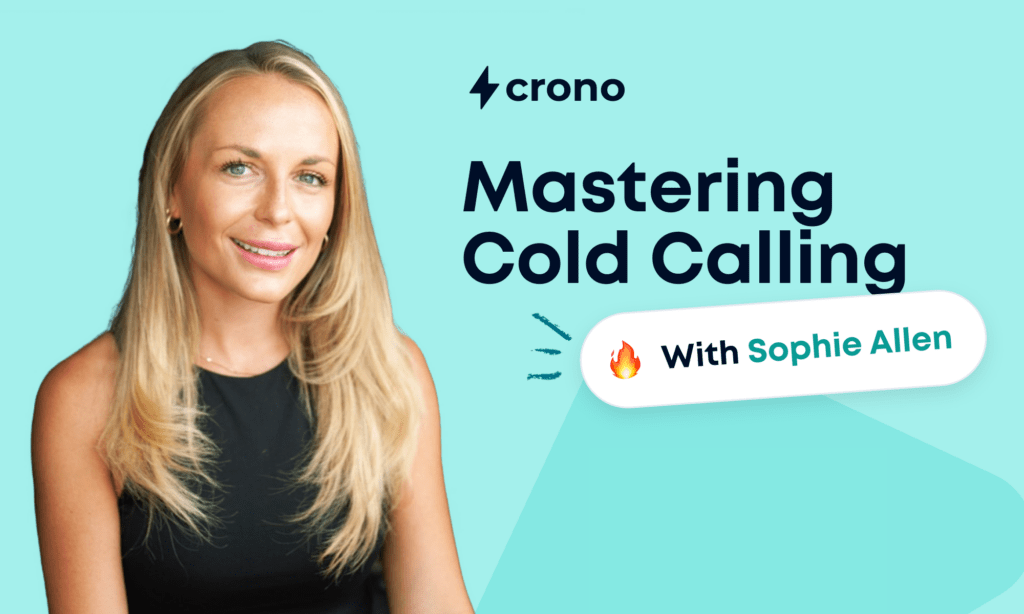Sophie Allen on Cold Calling
Last week we had the huge pleasure of hosting a special webinar with Sophie Allen in which we dove into Cold Calling. Sophie is an enthusiastic sales expert and her passion is contagious.
We’ve gathered her best tips here. Click on this link to view the full event.
Getting the right stack
First things first, Cold Calling is about mindset. Feeling empowered to do the job has something to do also with having the right equipment and tech.
So get the headset that makes you feel like a PRO, get the right software for recording and finding the right phone numbers and then focus on your calls.
Cold Calling doesn't have to be scary
Many people, especially in their early career days, are afraid to pick up the phone. It’s normal: you’re about to call someone, interrupting and you don’t know how they’ll react.
So here are 3 tips to get rid of that fear:
- Detach from the outcome: cold calling is a game of numbers. You may not get the meeting on your first attempt. Don’t focus on that but see every call as a way to become a better salesperson;
- Think of it as a conversation, because that’s what it is, simple as that;
- Don’t think of yourself as a seller. Yes, of course your ultimate goal is to sell but try a different approach. Less selling and more consultative.
When the prospect doesn't match your energy
There are two scenarios that actually scare salespeople: a vibe mismatch and objections.
The first one is when your prospect doesn’t match your vibe: they’re in a bad mood or simply not in the right moment. They might be giving you monosyllabic answers or sound bored.
The best thing you could do is tell them. They’ll appreciate your honesty and the way you can see their feelings. That will set a good start for a mutual agreement, whether it is to call later or someone else.
You’ll leave the call without friction and in a pleasant way.
Handling objections
And then, objections: here are my tips to deal with them with some tricks.
- Pause. Allow yourself 2 seconds of silence, creating tension and giving you the power to sound like you’re in control of the situation;
- Acknowledge the objection: make them feel seen and heard. You’re all ears, you’re open to confrontation;
- Ask a question. Don’t be disappointed by their reaction but rather intrigued. Ask a question to know more and dig deeper. “Out of curiosity…” is my go-to. They won’t expect it from you and you may find out that it’s not really an objection.
Structure matters
Having a strong calling structure gives you the confidence to pick up the phone. It’s important for cold calls not to be that long.
You’ll have time to make discovery calls but if you have all the elements, brace yourself and ask for a meeting. Don’t overcomplicate it.
Here are three elements to incorporate in your calls:
- A strong opening: it’s super important because the first seconds will influence the rest of your call. So be sure to nail that. I always start my calls with permission-based openers, stating who I am and clarifying that it’s a cold call. High energy and slow pace are the key to me;
- Transition statements. Now that you have your prospect’s attention head to why you’re calling. It can be a challenge they’re facing, some social proof (we’ve helped X company…) or just showing you’ve done your homework (I’ve seen that you recently closed a round...);
- Questions and CTA. As before, don’t overcomplicate it. Ask if they resonate, dig a bit and then ask for a meeting.
Bonus tip: try impact questions. For example, try to make your prospect picture their future.
“If you had focused/known on this challenge six months ago, how would your company be today?”
They bring a sense of urgency, powerfully placing your prospect in a scenario with what you’d like to sell.
Cold Calling dos and don'ts
Here are some common mistakes to avoid and good practices:
- Don’t use submissive language. Try to be confident, don’t use filler words just because you’re nervous. Be polite, sure but know your worth, you got this;
- Make the call about them. Once you’ve introduced yourself, the call should be all about your prospects. This tip is connected to the next one and this post by Josh Braun
3. Don’t focus on the features, focus on the value;
4. Show your personality, and be memorable. You don’t want to be boring.

